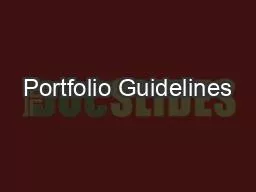

PAFAs A step by step guide to preparing your portfolio for your application Scroll down for tips on how to have a successful portfolio review Step 1 Do your research Each school has uni ID: 817875
Download Pdf The PPT/PDF document "Portfolio Guidelines" is the property of its rightful owner. Permission is granted to download and print the materials on this web site for personal, non-commercial use only, and to display it on your personal computer provided you do not modify the materials and that you retain all copyright notices contained in the materials. By downloading content from our website, you accept the terms of this agreement.
PAFA’s Portfolio Guidelines A ste
PAFA’s Portfolio Guidelines A step-by-step guide to preparing your portfolio for your application Scroll down for tips on how to have a successful portfolio review! Step 1: Do your research! Each school has unique criteria for what they look for in a portfolio – these guidelines will help you prepare your portfolio specifically for PAFA. Submit enough images. PAFA requires a portfolio of 12-15 strong images. We are interested in well-developed portfolios, and we look for a high level of skill, creativity, focus, and ambition. These works should explore concepts creatively and ambitiously, may be implemented observationally, imaginatively, or abstractly, and can be executed in any media. In every case, we want to see your strongest work. Step 2: Observational Work Show a few strong examples of observational work, especially drawing. This is the foundation of a successful portfolio; everything builds upon this skill. An observational piece is any image that you create while looking at actual subject matter. We ask that you do not use photographs as reference. The ability to translate a three-dimensional space into a two-dimensional image is a challenging task; it is critical that we are able to evaluate this ability. Step 3: Include Mature and Ambitious Work Your portfolio should also include work that is mature and ambitious. Ambition can mean a lot of things – experimenting with scale, materials, subject matter, etc. Your portfolio should display your strongest work – do not submit a piece that is ambitious if it is not finished. Include work you made outside of class assignments, and identify it as such. If you submit a class assignment, tell us how you altered it to make it your own. We love when you think outside the box! Step 4: Be Creative Your portfolio is just that… yours! It should distinguish you and reflect your strengths, your goals, and the direction you want to take as an artist. Step 5: Try Working in a Series An exceptional portfolio will deal with ideas and subjects in-depth. Try to develop a series of artworks that relate to each other and explore an idea more than once. Step 6: Tell Us Details Make sure to include the dimensions of each work, along with medium/media, and a description of content/process/idea. We are viewing your works on a computer, so including these descriptors really helps us to understand what your work looks like in real life.
Step 7: Ask Questions If
Step 7: Ask Questions If you are unsure about anything, don’t hesitate to ask questions. Our goal at the Office of Admissions at PAFA is to help you create a successful portfolio. We are happy to do an in-person or virtual portfolio review with you! You can reach us by phone at 215-972-7625, or by email at admissions@pafa.edu. Step 8: Submit Your Portfolio! Applicants should submit their portfolio of 12-15 images online, via SlideRoom, at www.pafa.edu/apply. For good image quality and fast upload, we recommend that all portfolio images should be in JPEG format. How To Have A Successful Portfolio Review Follow this step-by-step guide of tips and tricks from PAFA to have a great review! Step 1: Introduce Yourself! Tell us your name and what year in school you are – we like to know a little bit about you as well as looking at your work! Ask the reviewer how he/she would like to view your work. Each reviewer has a different review process, so asking this question helps you understand how the review will happen. Step 2: Be Open to Suggestions The reviewer will want to have a conversation with you about your work and might make some suggestions based on what they’re looking at. Know that there are no “wrong” answers to any questions they ask you. Step 3: Talk to Them Explain why you’re doing certain types of works, what the assignment was, how you worked on the piece, and what the reactions were to the work when it was presented. Since the reviewer only spends a short time looking at your work, they like to get a better understanding of your choices by hearing you talk about the “behind-the-scenes” of the work. Step 4: Ask Questions! If anything the reviewer says is unclear, ask them to explain. It’s also a good idea to take notes so you can carefully consider their suggestions and advice when you get home from the review. This is also a great opportunity to ask any questions that you may have about the school. Step 5: Do Not Worry or Get Upset Do not become defensive if the reviewer is pointing out weaknesses. They are trying to help you learn, and they will give you some tips on how to work on these weaknesses. No reviewer will be mean to you – they want you to succeed! The goal of a portfolio review is to assess the work you have completed so far, to help you in getting that work ready to submit with your application, and to help you strive to continue to grow as an artist